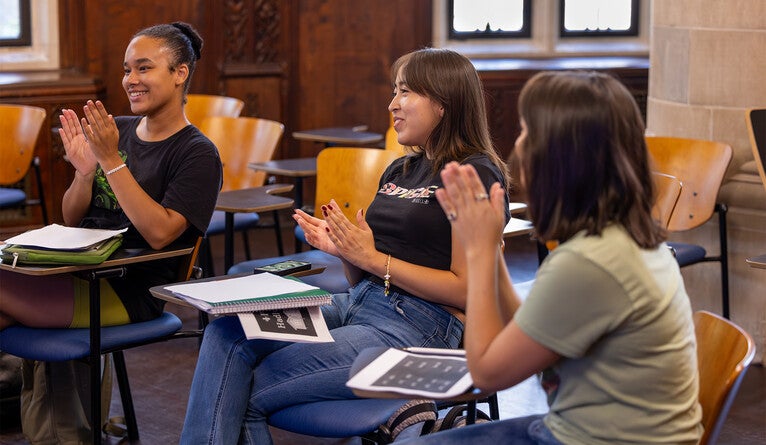Video
Lector of Cherokee is Yale’s first faculty member in an Indigenous language
Patrick Del Percio first showed an interest in learning the Cherokee language at the age of seven, when their family visited a living history museum portraying a 1760s Cherokee village. Del Percio asked the tour guide for the Cherokee word for “hello.”
They hadn’t been raised around Cherokee culture, but knowing that their family heritage did include Cherokee, Del Percio was compelled to learn more about it. (Del Percio is not an enrolled citizen of the Cherokee Nation.)
“I was a nerdy little kid, and really interested in where I come from and understanding that better,” they said. By the age of 13, Del Percio was taking online Cherokee language classes through the Cherokee Nation. After just one class with a native speaker, “I knew I wanted to become fluent.”
Eighteen years later, Del Percio is still pursuing their love for the language as a lector in the Department of Linguistics in Yale's Faculty of Arts and Sciences (FAS), the university’s first full-time faculty member in an Indigenous language.
This fall, for the first time, Yale students have the option of taking “Beginning Cherokee I.” The university is the only Ivy League institution to offer a North American Indigenous language for credit, according to Claire Bowern, a professor of linguistics who was instrumental in getting the language added to the curriculum.
“We tend to treat languages other than English as ‘foreign’ languages,” Bowern said. “But the U.S. has always been a multilingual country. And it’s important for students who come to Yale to be able to study languages that are from the continent.”

Indigenous language courses have previously only been offered through the campus Native American Cultural Center and the Directed Independent Language Study program. Those courses did not fulfill the Yale’s language requirement.
Students have long pushed for the university to offer Native American language instruction for credit. And they have done so “in particularly organized capacities” since the first Native American Language Project community classes were formed at the cultural center in 2015, said Ned Blackhawk, the Howard R. Lamar Professor of History and American Studies, and a faculty affiliate of the Native American Cultural Center.
“For too long, language study has focused on languages non-Indigenous to the continent,” Blackhawk said.
The addition of a course in Cherokee comes just after the United Nations named 2022-2032 the International Decade of Indigenous Languages, citing the need for sustained efforts to prevent their extinction.
Del Percio was previously an instructor of Cherokee language in the University of Oklahoma’s Department of Native American Studies. They have also worked as a contract translator and curriculum developer for the Cherokee Nation Language Program, and co-authored a textbook in beginning Cherokee.
In its search for a lecturer, the search committee did not specify Cherokee, Bowern said, but rather left it open to any North American Indigenous language.
“We just really wanted to get a fantastic teacher, and Patrick emerged as the successful candidate,” she said. “Cherokee makes sense as a language at Yale because we have a lot of related materials in the Beinecke Library, and we have students who are members of the Cherokee Nation pretty regularly.”
Del Percio attributed their proficiency in Cherokee — which is considered one of the more difficult languages to learn — to the many first-language speakers who supported, accepted, and welcomed them over the years. Having that personal interaction is crucial in learning Cherokee, they said, because it’s a tonal language.

“There are five or six tones in the language,” Del Percio said. “Saying a word using the wrong tone can change its meaning. It’s hard to learn the language from a book because you can’t get the full melody of the language. You really have to hear those speakers over and over and over again.”
Del Percio hopes to give Yale students that opportunity by bringing first-language speakers into the classroom, as well as by using audio recordings.
They also want to incorporate the many Cherokee language materials that are stored at the Beinecke, part of the Yale University Library. Del Percio has already transcribed some of these materials for a separate project (based at Northeastern University) called the Digital Archive of Indigenous Language Persistence. The materials include personal histories, stories, letters, and funeral notices, all written in Cherokee.
“It’s amazing,” Del Percio said. “There’s so much to utilize from that collection to teach the language.”
Yale’s decision to offer the course will perhaps encourage more universities to do so, they said. (A handful of state universities do offer Indigenous languages, usually ones with ties to their regional location.)
“It’s important to see Indigenous languages represented everywhere,” Del Percio said. “And I hope this opens up the door for other Indigenous languages to be represented here at Yale.”
The Cherokee Nation Language Department, based on the nation's reservation in Oklahoma, regularly educates thousands of students in online and community classes, adult and child immersion classes, and a master apprentice program. After considerable growth over the past decade, the programs now produce about two dozen proficient speakers a year, said Howard Paden, the executive director.
That’s not enough to keep pace with the number of fluent speakers who are passing on, but “we’re moving in the right direction,” Paden said. “We believe our nation is in the golden age period where we’re able to save some of the things that were at risk of being lost for future generations.”
He recalled when Del Percio first started learning the language, and sought out guidance from the Cherokee elders, including the late Durbin Feeling, a renowned linguist and longtime leader in efforts to preserve the language.
“Patrick was one of Durbin’s many projects,” Paden said. Now, they’re “going out in the world pushing what Durbin pushed all along.”
Related